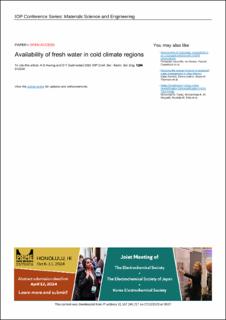| dc.contributor.author | Awong, Nu Dah | |
| dc.contributor.author | Gudmestad, Ove Tobias | |
| dc.date.accessioned | 2023-12-29T13:34:39Z | |
| dc.date.available | 2023-12-29T13:34:39Z | |
| dc.date.created | 2023-12-26T14:44:37Z | |
| dc.date.issued | 2023 | |
| dc.identifier.citation | Awong, N.D., Gudmestad, O.T. (2023) Availability of fresh water in cold climate regions. IOP Conference Series: Materials Science and Engineering, 1294 | en_US |
| dc.identifier.issn | 1757-8981 | |
| dc.identifier.uri | https://hdl.handle.net/11250/3109159 | |
| dc.description.abstract | Challenges related to the availability of fresh water in cold climate regions are discussed with emphasis on possible degradation of the quality of drinking water. The permafrost in this region has been consistent in making sure there is little drainage in the ground. This is important, as fresh water is mainly supplied through melting water from snow and ice in the many winter months. Climate change and warmer weather plays a role in heating up the permafrost and increasing the rate of the melting snow. This has an impact on both the amount of water and potentially the drinking quality. In certain cold region areas, fresh water sources are located not far from the shore. With increased shorline erosion due to warming climate, the fresh water supply is in danger of being contaminated by salt water during large storm events. Furthermore, human activities such as road transport and sewage contamination do also have a significant impact on the water's quality. A bowtie diagram will be used to illustrate the different risk factors and suggestions on how to maintain the quality of fresh water supplies in cold climate areas. The primary focus areas will be Isdammen, near Longyearbyen on Svalbard and Utqiagvik (formerly Barrow), Alaska. | en_US |
| dc.language.iso | eng | en_US |
| dc.publisher | IOP Publishing | en_US |
| dc.rights | Navngivelse 4.0 Internasjonal | * |
| dc.rights.uri | http://creativecommons.org/licenses/by/4.0/deed.no | * |
| dc.subject | drikkevann | en_US |
| dc.subject | permafrost | en_US |
| dc.subject | klimaendringer | en_US |
| dc.title | Availability of fresh water in cold climate regions | en_US |
| dc.type | Peer reviewed | en_US |
| dc.type | Journal article | en_US |
| dc.description.version | publishedVersion | en_US |
| dc.subject.nsi | VDP::Teknologi: 500 | en_US |
| dc.source.pagenumber | 11 | en_US |
| dc.source.volume | 1294 | en_US |
| dc.source.journal | IOP Conference Series: Materials Science and Engineering | en_US |
| dc.identifier.doi | 10.1088/1757-899X/1294/1/012034 | |
| dc.identifier.cristin | 2217580 | |
| dc.source.articlenumber | 012034 | en_US |
| cristin.ispublished | true | |
| cristin.fulltext | original | |
| cristin.qualitycode | 1 | |

